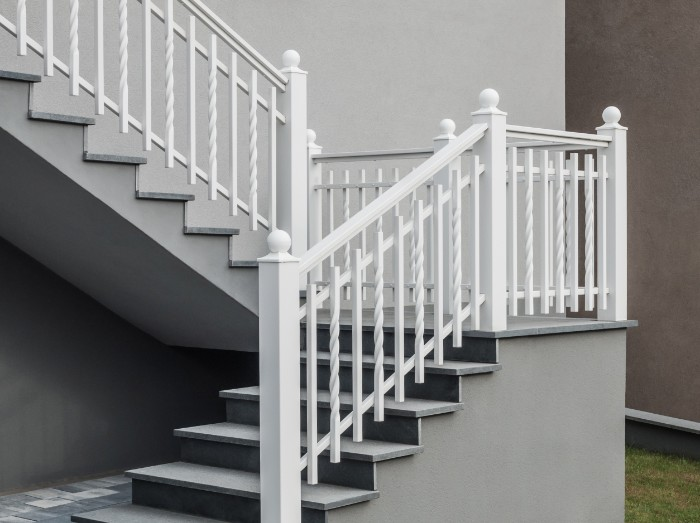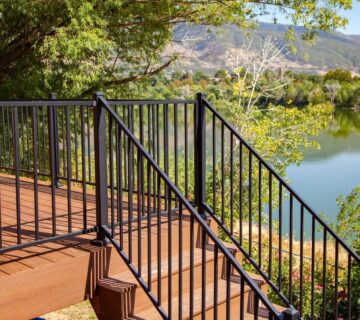Choosing Railing Color for Your Property
When it comes to enhancing the aesthetic appeal and functionality of your home or commercial space, choosing the right railing color can make a significant difference. Railings not only provide safety and support but also serve as a design element that can complement your overall decor.
With a wide range of color options available, selecting the perfect railing color can seem like a daunting task. In this article, we will explore some essential elements to consider when choosing a railing color, helping you make an informed decision that suits your style and enhances your space.
Railing Color: Architectural Style and Surroundings
Consider the architectural style of your building and its surroundings when selecting a railing color. The railing should harmonize with the overall design and blend seamlessly into the environment. For a traditional or historical-style home, classic colors such as black, bronze, or white can be an excellent choice. These colors provide a timeless and elegant look that complements the intricate details and craftsmanship often found in traditional architecture.
They create a sense of sophistication and add a touch of refinement to the space.
On the other hand, contemporary or modern buildings offer more flexibility when it comes to color choices. These structures often feature clean lines, minimalist designs, and a focus on simplicity. Opting for more vibrant and contrasting colors can help create a bold statement and infuse a sense of energy into the space.
Consider colors like vibrant red, deep blue, or striking silver to add a touch of modernity and create visual interest. When assessing the architectural style, also take into account the surroundings of your building. Consider the natural elements, landscapes, or urban environment that surround your space.
If you have a building located in a lush green setting, earthy tones such as warm browns or forest greens can help the railing blend seamlessly with the natural surroundings. For buildings situated in urban areas with a more modern and industrial vibe, sleek and metallic colors like silver or gray can complement the urban landscape and provide a contemporary feel. Additionally, consider the materials used in the construction of your building.
Personal Preference and Design Goals
Your personal preference and design goals should be taken into account when choosing a railing color. This factor allows you to infuse your unique style and create a space that resonates with your personality. Consider the ambiance you want to create in your space and the overall theme or mood you want to evoke.
If you prefer a subtle and understated look, opt for soft and muted colors. Shades like light gray, beige, or pastel tones can create a calm and relaxing atmosphere. These colors work well in spaces where tranquility and serenity are desired, such as bedrooms or meditation areas. They provide a soothing backdrop that allows other design elements to take center stage.
On the other hand, if you’re aiming for a more dramatic and eye-catching effect, vibrant hues can add energy and excitement to your space. Colors like bold red, vibrant blue, or sunny yellow can make a powerful statement and create a lively atmosphere. These colors are ideal for areas where you want to inject vibrancy and create a sense of playfulness, such as entertainment rooms or outdoor spaces.
Consider your personal style and how the railing color aligns with your overall design goals. If you have a preference for modern and sleek aesthetics, you may lean towards metallic colors like silver, chrome, or brushed stainless steel. These colors provide a contemporary and sophisticated look, perfect for urban and minimalist designs.
Maintenance and Durability
When choosing a railing color, it is important to consider the maintenance and durability aspects. Different colors may have different maintenance requirements to keep them looking their best over time. Lighter colors, while visually appealing, tend to show dirt, fingerprints, and other marks more easily.
This means that they may require more frequent cleaning to maintain their pristine appearance. If you opt for a lighter railing color, be prepared to invest time and effort into regular cleaning and upkeep. On the other hand, darker colors such as black or deep browns have the advantage of being able to hide imperfections. They are more forgiving when it comes to showing signs of wear and tear. This can be particularly advantageous in high-traffic areas or outdoor spaces where the railing is exposed to the elements.
Darker colors tend to require less maintenance in terms of cleaning and touch-ups.
In addition to considering the color itself, it is essential to assess the durability of the railing material. Look for materials that are resistant to fading, chipping, and corrosion. This is especially important for outdoor railings that are exposed to sunlight, rain, and temperature fluctuations. High-quality finishes and materials will ensure that your chosen railing color remains vibrant and intact for years to come, with minimal maintenance required.
Lighting Conditions
Consider the lighting conditions in and around your space when selecting a railing color, as lighting can significantly influence the appearance and perception of color. Natural sunlight, artificial lighting, and even the time of day can all impact how colors are perceived, making it essential to evaluate the color options under different lighting conditions.
To gain a comprehensive understanding of how the railing color will look throughout the day, it is advisable to obtain color samples and observe them in various lighting scenarios. Start by examining the colors under direct sunlight. Natural sunlight tends to provide the most accurate representation of color, as it showcases the true vibrancy and nuances of different shades. Take note of how the color appears in bright sunlight and whether it aligns with your desired aesthetic.
Complementary or Contrasting Colors
When choosing a railing color, it’s important to consider the existing color scheme of your space. Choose a complementary or contrasting color to enhance your space with our railing options. Both approaches can have a significant impact on the overall aesthetics of your space.
Complementary colors are those that are located opposite each other on the color wheel. These colors create a harmonious and balanced look when used together. Choosing a railing color that complements the surrounding elements means selecting a color that blends in seamlessly with the overall color palette. This approach creates a sense of unity and cohesiveness in the space. Match your warm earthy space with a rich brown or deep bronze railing for a harmonious visual flow.
At Alumiguard Manufacturing, we understand the importance of both functionality and aesthetics when it comes to railing systems. Choose the perfect railing from our wide selection of materials, styles, and colors to match your space.



